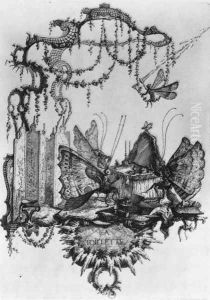Charles-Germain de Saint-Aubin Paintings
Charles-Germain de Saint-Aubin was born in 1721 in Paris, France, into a family deeply involved in the arts. His father, Gabriel-Germain de Saint-Aubin, was a painter and draftsman, and his siblings also pursued creative careers. This environment nurtured his talents from a young age, and he grew up to become an influential figure in French art, particularly in the realms of embroidery and illustration.
As an artist, Charles-Germain de Saint-Aubin was appointed as the designer to the king's embroidery workshop (dessinateur du roi pour la broderie et la dentelle) in 1755. This prestigious position reflected his expertise in textile design and his ability to create intricate patterns for fabrics used in the court of King Louis XV. His contributions to embroidery are significant; he elevated the craft to an art form, blending innovative techniques with artistic creativity.
Beyond textiles, Saint-Aubin is noted for his sketches and drawings. He compiled a collection of his works in a famous album known as 'L'Album de Saint-Aubin', which is held at the Louvre Museum. This album provides valuable insights into the social and artistic life of Paris in the 18th century, as it includes a wide range of subjects from detailed studies of everyday objects to satirical commentaries on contemporary society.
His book, 'L'Art du Brodeur' (The Art of the Embroiderer), published in 1770, remains a significant work on the subject of embroidery. In it, he detailed the techniques and materials of the craft, offering guidance that was both practical for craftsmen and informative for connoisseurs and historians. The book underscores his mastery of the medium and his ability to articulate its complexities.
Charles-Germain de Saint-Aubin's influence extended to his siblings, including his brother Gabriel Jacques de Saint-Aubin, who was a notable draughtsman and painter, and his sister Marie Louise, who became an accomplished miniaturist. His work and that of his family members provide a vivid portrait of artistic life in pre-revolutionary France.
Saint-Aubin's legacy is that of an artist who bridged the gap between craft and fine art, bringing the former to the attention of the art establishment of his time. His works are celebrated for their technical proficiency, their elegance, and their wit. He died in 1786, having left a mark on the world of French art and the broader tapestry of 18th-century European culture.
